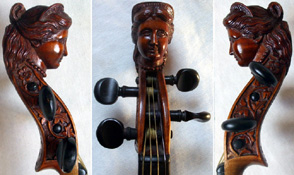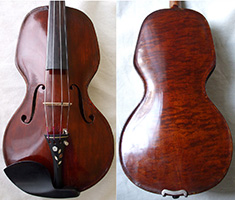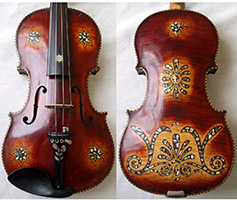
| • | home | • | • | • | instruments for sale | • | videos from our workshop | • | payment | • | • | • |
|
• | ||||
| • | contact | • | • | myth | • | appraisals | • | accessories | • | archive | • | • | • |
Please also see "myths" !
Let us say something about violin labels and their backround through our own knowledge and experience:
After having thousands of violins going through our workshop, we have to say, that a very high percentage of labels found in old violins are simply FAKE !
Mostly forged into the body by ruthless sellers with the intention to raise "value" on unexperienced buyers. Sad - but true !
So please note this:
Disregard violin labels unless the label is explicitly guaranteed to be authentic and original to the violin. Incorrect labels have been inserted in violins for centuries, and it still happens today. There are many reasons for this rather obscure phenomena, but even many very fine violins have incorrect labels. Sometimes, the incorrect label can even be that of a less valuable maker than the actual maker. Often, Asian, German, Eastern European, Western European and American violins have labels of Italian makers. Sometimes new, highly antiqued violins have labels of freely invented modern Italian luthiers. Some of these violins are very good, but have low market value.
Most of the genuinely old violins on eBay or other auction sites are German, followed probably by French. Some old German violins are excellent even if they have a fake label. Likewise also Mirecourt violins and most older French violins. Some German violins also have fake French labels.
Be aware - inserting a faked label into a violin is nearly as easy than putting a stamp on a letter!
... and unfortunately there will be always people to do this !
That's why you should consider following fact: If you're buying a violin on the internet - even from the most renown dealers - you should expect it to be correctly and honestly described, especially when it comes to the label and provenance:
In our descriptions we show a detailed XXL photo of the label or brand stamp !
On all our violins we offer a video / soundfile linked, as well as detailed XXL pics from all different angles possible - just click on the images. Measures and weight are also stated in the descriptions.
All violins we offer have been checked in our workshop by our luthiers and by our violinist on tonality and playing conditions. Existing issues like open seams or cracks, old repairs, missing parts or required improvements have been taken notice of, and if necessary - revised and carefully worked over.
Our violins will sound and play well if you do so, and a little fine tuning will likely improve them.
Here're some tips how you may spot a faked label (examples) :
Take a modern digital camara and hold the lens directly onto the (mostly left) f-hole by daylight to get a good detailed shot of the label. Now blast the photo up with a image editing program like adobe photoshop or similar. If you see the letters "pixeling" when you reach the own 100% pixel-rate (or higher) of the actual photo, it's most likely a photocopy.
Or:
First jugde the label by the age dated and how it lookes to you:
Has it might been set in a shorter while ago? You might be able to get a hint by looking to the edges of the label, rests of glue or dust on and around the label, as well in other parts of the body.
Does the paper itself and/or the type of letters / spelling fit the time period? Comparing scripts or type of letters on other publications like old books of the particular time period might give you an idea.
What color is the label?
An original antique violin label will change color as it ages. The reaction of the paper against the wood, along with any other atmospheric changes, causes the paper to darken. Likewise ink or printed letters fade in density. Both the wood and the label should be a similar shade of brown.
What do the edges of the label look like?
The edges of the label itself should blend in cleanly to the wood surface. If there is any curling at the edges exposing lighter-colored wood underneath, it might be caused by athmospheric (huminity, room temperature) changes. But if the label and the area around is darkend, it probably means the surface was treated to look old after a false label had been inserted.
Has the label been removed at any point?
An original label may have been removed for repair, regraduation of the back, or even for transfer to another instrument. This is incredibly common, so it is an extremely rare and wonderful occurrence when you find an instrument with an original and undisturbed label!
.... and most important: the paper structure !
Laid paper is a type of paper having a ribbed texture imparted by the manufacturing process. In the pre-mechanical period of European papermaking (from the 12th century into the 19th century), laid paper was the predominant kind of paper produced. Its use, however, diminished in 2nd half of 19th century, when it was largely supplanted by wove paper.
In any case, be aware that there's a lot of forgery on violin labels!
Please also see our videos about fake labels and section "myths" !
... to be continued ...

